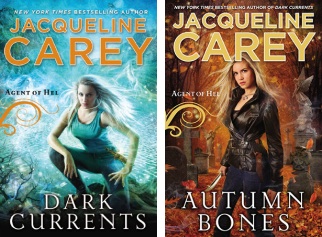Jacqueline Carey is perhaps best known for her richly-described Kushiel novels, set in a fantasy world whose regional cultures owe a significant debt to real-world historical or legendary counterparts. Her young adult novels Santa Olivia and Saints Astray demonstrated her ability to write outside the epic fantasy context that made her reputation. Now, with 2012’s Dark Currents and 2013’s Autumn Bones, the first two novels in the Agent of Hel series, Carey makes an entry into the urban fantasy field.
It’s an entry I really rather like.
Daisy Johanssen is the only child of a single mother. She works part-time as a file clerk at the police station of Pemkowet, a small American town. Pemkowet is not your average small town: the goddess Hel has set up shop nearby, there are fairies in the streets, one of the police officers is a werewolf, and it advertises itself as the premier destination for paranormal tourism. Daisy herself isn’t entirely human. An accident with a ouija board resulted in her mother becoming pregnant by a minor demon from the Christian Hell, so Daisy has a bit of a tail and the minor problem that if she ever claims her birthright, she could trigger the end of the world.
Dark Currents is constructed around the investigation of a crime. A young man is dead—drowned in salt water, but his body has been found in freshwater. And there’s something supernatural involved. Daisy is the local paranormal world’s liaison to the mortal authorities, so it’s up to her to find out what the supernatural involvement might be. Partnered with attractive young police officer (and werewolf) Cody Fairfax, she has to work with leader of the local ghouls*—and their biker club—the handsome and very old Stefan Ludovic, in order to track down what has been going on and make sure it doesn’t happen again. Meanwhile, the Pemkowet Visitors’ Bureau wants Daisy’s help in convincing the fairies to play nice with a paranormal bus tour, which dashing Jamaican ex-pat Sinclair Palmer is setting up in town.
*Carey’s ghouls are essentially emotional vampires—but with some interesting metaphysical world-building.
With all these attractive men around, one gets the feeling that Carey’s having a lot of fun playing with the conventions of a subgenre often involving, as Tansy Rayner Roberts put it, “angry ladies in leather trousers, having lots of sex with monstrous men, and kicking butt.” And she is: her characters for the most part act like adults, and talk to each other about their attraction or lack thereof to each other—in amongst a great deal of investigating and Cool Shit.
But the Agent of Hel books don’t belong to the noir-ish end of the urban fantasy spectrum, or to the romance end either. Tonally, the closest match seems to be an energetic cosy mystery—although some deeply unpleasant things are revealed.
Autumn Bones changes the focus away from investigating, and more into the dynamics of family and friendship. Sinclair Palmer’s family want him to come home to Jamaica; when he doesn’t go, his mother and sister unleash a magical threat against the town of Penkowet—and it’s up to Daisy and her collection of friends and allies to get things back under control. Autumn Bones is in some respects a weaker book than Dark Currents, due to the fact that the resolution of one mystery is so obvious that it seems impossible the characters involved aren’t more suspicious… but it has its fair share of Cool Shit, which rather makes up for that.
Something I really enjoy about these two books is the variety of (female) characters who are involved in Daisy’s life. Urban fantasy as a marketing category has a bit of a bad rep in this department. A lot of the time, if the main character is a woman, the vast majority of her interactions are with men: there can be a whiff of the Smurfette about her. But that’s not the case here. Daisy is surrounded by many and varied other women: her best friend, the entirely human Jen Cresswell; her mother; Lurine, an old and powerful supernatural woman who plays the role of Daisy’s older sister; and several more. It is a small thing, and it makes me disproportionately happy.
These two books aren’t without their problems, but I found them tremendously entertaining, and I would really like to see more urban fantasy like them.
Before I sign off this week, I think I should mention some news. Starting in December, and continuing for the foreseeable future, this column is moving from a weekly schedule to a monthly one. Your not-so-humble correspondent still has just as many cranky opinions to share—but unfortunately, I also have a thesis to finish in the coming year.
Liz Bourke is a cranky person who reads books. Her blog. Her Twitter.










